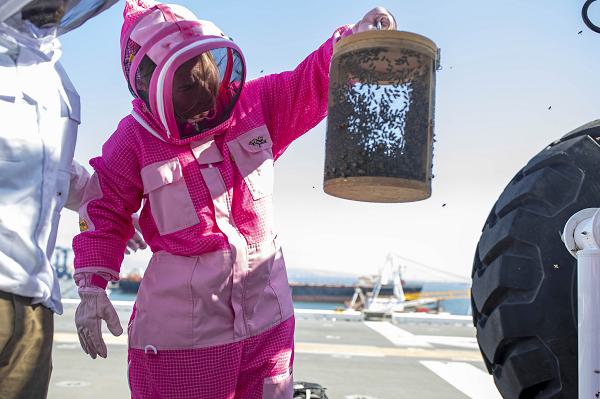
Naval Base San Diego, California. (June 17, 2024): “Surely, beekeeping can’t be a military occupation,” asked a representative of Support Our Troops of public affairs officials at the base here. We had hoped to interview Lieutenant Junior Grade Kaylee Newcomb, pictured above in her protective equipment removing bees from the USS Tripoli. (Photo by Seaman Recruit Eliora Sims). America’s enormous warships provide an attractive place for bees to establish their hives but naturally this can be a threat to crew safety.
What is astonishing is that Newcomb, a cyber warfare officer aboard an assault ship, would have the knowledge, equipment, and skills to move a swarm of bees safely to their new location.
Is there a class at Cyber School for bee removal?
Having not heard from Lieutenant Newcomb, we decided to do some digging on our own and learned a lot about bees in the process. Interestingly, bees are very aware of and loyal to their hive and it takes some pushing to make them want to leave. There is a saying among bee types that you can move a hive “three feet or three miles” and they will find their way home. If the distance is more than three miles, bees cannot recognize their location and must reorientate themselves to their unfamiliar environment. It is as if they wake up in a different landscape and GPS location which can be very disorienting for our bee friends.
Bees are so attached to the location of their hives that they pirouette as they leave the entrance, always keeping an eye on the way home. They fly in small figure eights in front of the hive gathering information about landmarks and the sun’s direction before they head out to forage for nectar, pollen, and water.
To move a hive, protective gear including a full bee suit, gloves, and a veil is an absolute must. If relocating a short distance, it is not necessary to cover the entrance as the bees will follow the hive to the new location easily. If longer distances are involved, there are a couple of considerations to preserve the health of a bee colony.
First, beehives are fragile and great care must be taken to support the bee colony during transit. Temperature and ventilation are also important as hives can overheat quickly so adequate air flow is critical. Beekeepers typically wait until the night before moving a hive to ensure all the bees have returned home.
Once at their new home, beekeepers reestablish a hive location to provide a safe new home for these productive insects.


